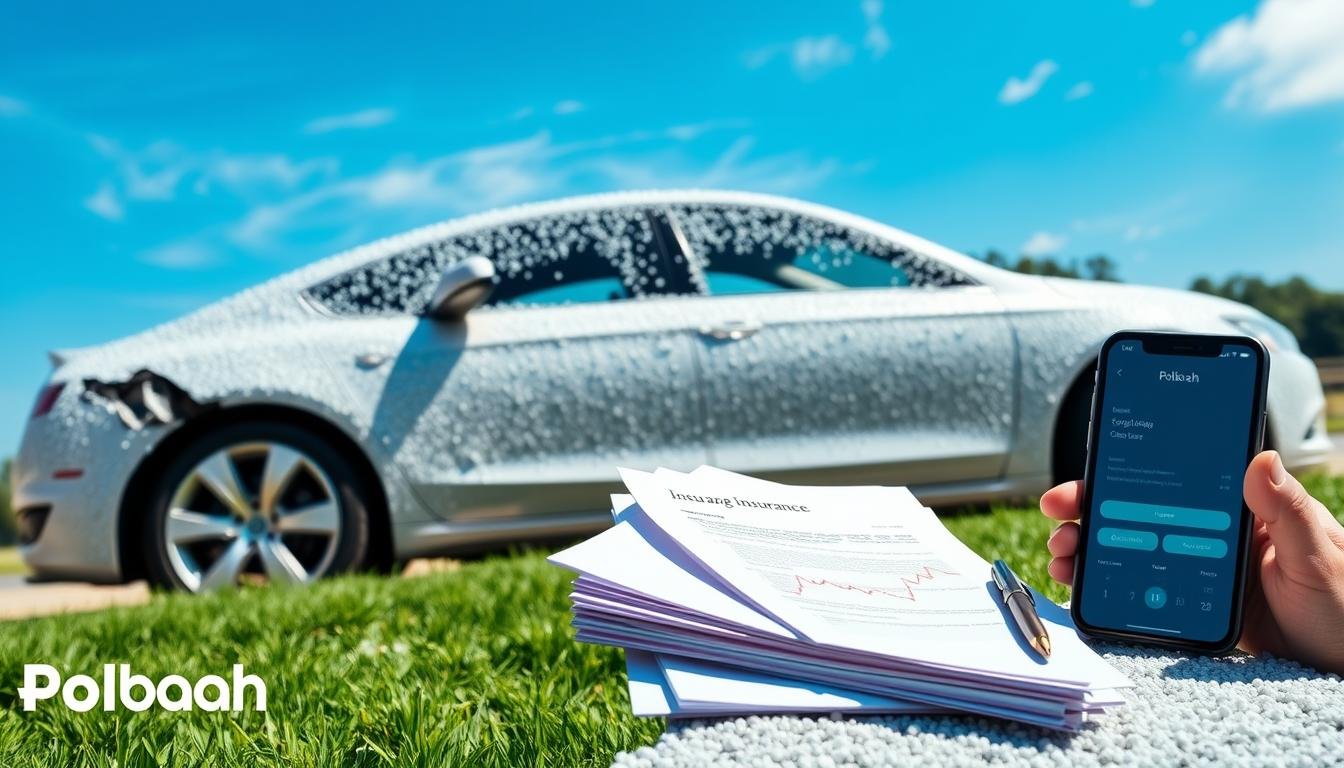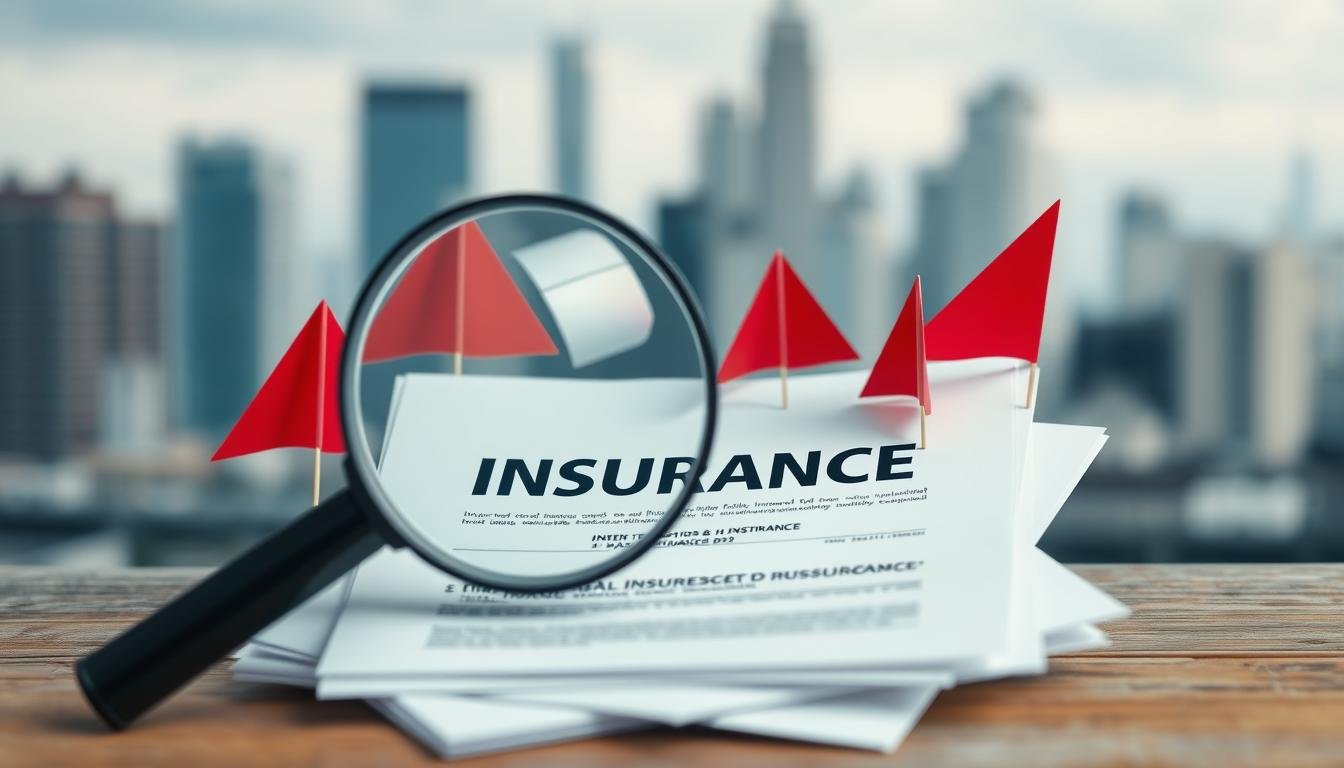Filing hail damage car insurance claims can feel daunting after a hailstorm. This guide aims to simplify the process. It helps you understand your rights and the steps to take. This way, you can get a fair settlement.
It draws from trusted sources like the National Association of Insurance Commissioners and Consumer Reports. You’ll learn how to handle your claim effectively.
Key Takeaways
- Filing hail damage car insurance claims is essential for vehicle recovery.
- A thorough understanding of the claims process can lead to better outcomes.
- Documenting damage accurately is a key component of successful claims.
- Knowing your policy details can help in maximizing your claim.
- Prompt action is crucial to meet insurance deadlines and ensure timely recovery.
- Familiarize yourself with common mistakes to avoid in the claims process.
Understanding Hail Damage and Its Impact on Your Vehicle
Hail damage can show up in many ways, affecting your car’s condition. It’s key to know about hail damage to spot problems that aren’t obvious at first. When hail hits your car, it can make dents, break windows, and even harm the car’s structure.
The impact of hail damage on vehicles depends on the size and speed of the hailstones. Small dents might be fixed with special dent removal, but big damage needs more work. Spotting car hail damage early is important. If you ignore small problems, they can get worse and cost more to fix later.
Hail damage isn’t just about physical harm. It can also lower your car’s value and safety ratings. Dents and broken glass might scare off buyers, and safety issues can be dangerous. Knowing about hail damage helps you decide on repairs and insurance claims wisely.
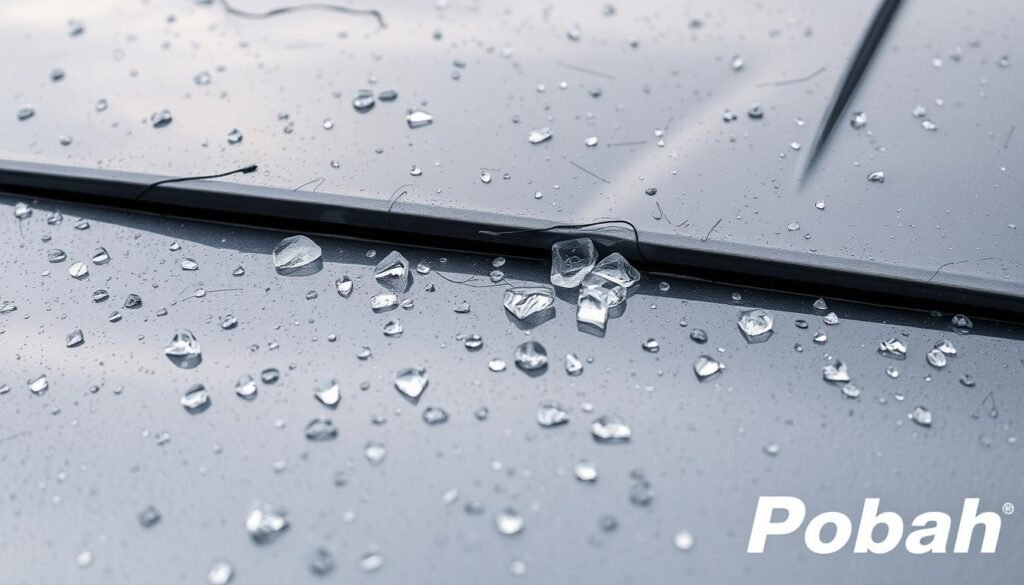
- Dents: Can vary from minor imperfections to severe deformities.
- Broken windows: May necessitate a full glass replacement.
- Structural issues: Can affect alignment and safety features.
| Type of Hail Damage | Description | Repair Method |
|---|---|---|
| Minor Dents | Small, cosmetic surface damage | Paintless dent repair |
| Broken Glass | Shattering of windows or mirrors | Replacement of glass |
| Severe Dents | Deep, significant indentations | Body shop repair and repaint |
What to Do Immediately After a Hail Storm
When severe weather hits, acting fast is key. The steps you take after a hail storm can greatly affect your car’s damage and insurance claims. First, document the storm’s details to show its intensity and how long it lasted.
After the storm, check your car for damage. If it’s safe, move it to a spot away from falling debris. Look for dents, cracks, or scratches. These need to be reported to control damage after hail.
Call your insurance right away to report the incident. This step helps speed up your claim and gets you the help you need. Keeping in touch with your insurer makes things easier.
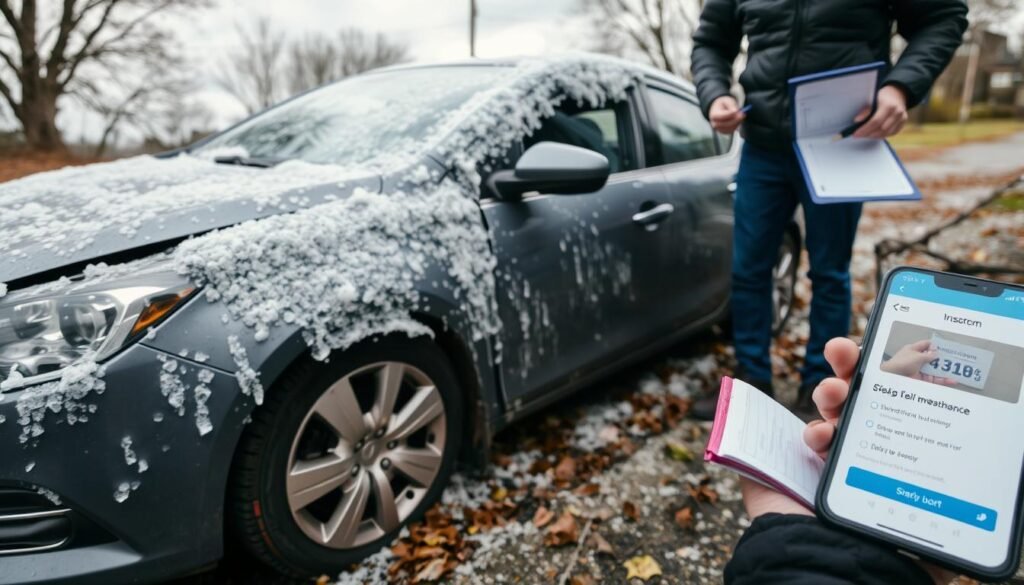
- Document the storm details (time, duration, severity).
- Assess immediate damage to your vehicle.
- Relocate your vehicle to a safe area if possible.
- Contact your insurance provider promptly.
Most importantly, these first steps help control damage after hail. They make the claims process smoother. Your quick action can greatly help you recover from unexpected events.
The Comprehensive Guide to Filing a Hail Damage Car Insurance Claim
After a hailstorm, acting fast is key for a successful claim. Knowing the insurance claim process well can make a big difference. It helps you avoid problems and get the compensation you need.
Importance of Timely Action in the Claims Process
Being quick when filing a claim is very important. Reporting damage right away helps your insurer understand your situation better. Waiting too long can cause issues, like your claim being denied.
Start by taking photos of the damage and then call your insurance. This ensures you meet the necessary deadlines and avoid missing important claim deadlines.
Overview of Insurance Claim Deadlines
Each insurance company has its own rules for claim deadlines. They usually want you to file within a certain time after the damage. Knowing these deadlines is crucial.
Make sure to follow your insurer’s rules closely. Missing a deadline can mean you won’t get paid for your car’s damage. Keep all records of talks with your insurer to stay on track.
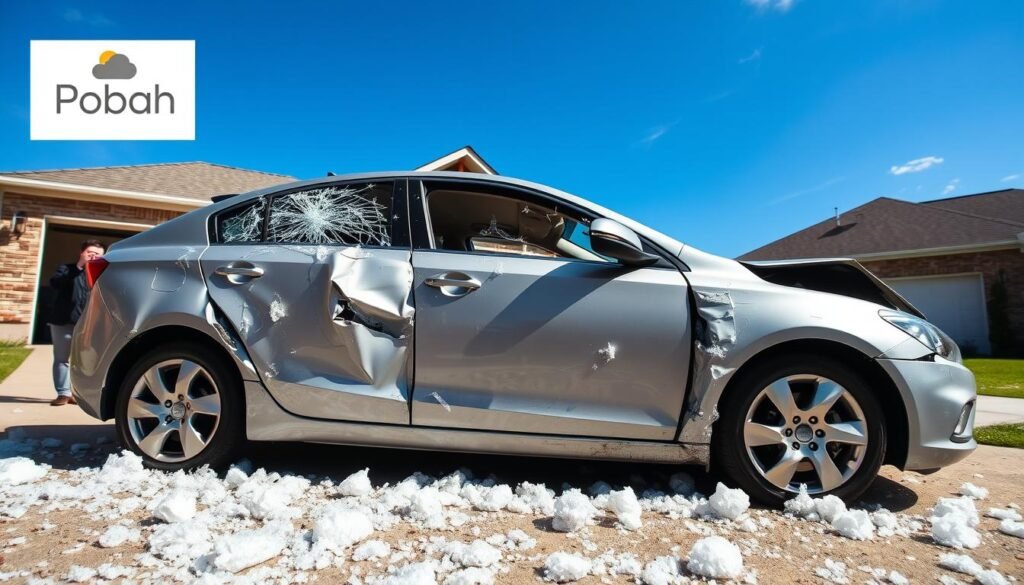
Assessing the Damage to Your Vehicle
After a hail storm, it’s crucial to check your car for damage. Look for different types of damage and how bad it is. Knowing this helps decide if you should file an insurance claim and what to report.
Conducting a Thorough Car Damage Assessment
Start by looking at your car’s outside carefully. Check for:
- Dents and dimples on the body panels
- Cracks in the windshield or windows
- Chips or scratches in the paint
Check each part of the car to make sure you find all damage. Pay extra attention to the roof, hood, and trunk. These areas often get hit the hardest. If you see big damage, get a pro to give you a detailed report.
Identifying Types of Hail Damage
Knowing the different types of hail damage is key. Common types include:
| Type of Hail Damage | Description |
|---|---|
| Cosmetic Damage | Minor dents that don’t hurt the car’s performance but mess with its look. |
| Paint Damage | Scratches or chips that show metal, which can rust if not fixed. |
| Structural Damage | Big hits that hurt the car’s body or frame. |
Getting expert help makes understanding the damage better. It prepares you for talks with your insurance and makes sure you get the right fix. A clear report of the damage helps your claim.
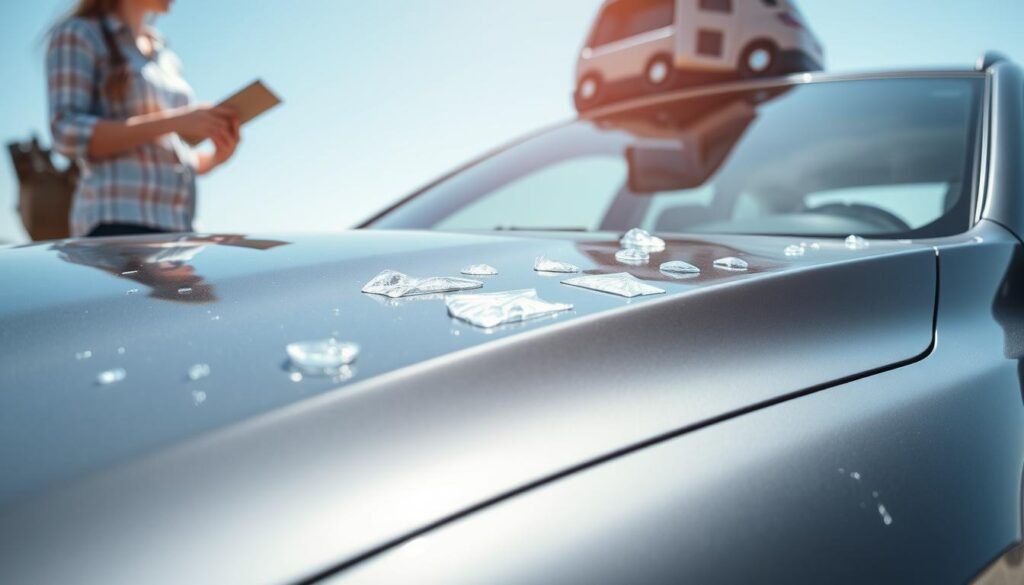
Documenting Your Hail Damage for the Insurance Claim
When you file your insurance claim for hail damage, good documentation is key. You must collect all the evidence you need. Start with a detailed claim checklist. This guide will help you gather everything required. You can also use photos to show the damage clearly.
Claim Documentation Checklist
Here’s a checklist to help you organize your documents:
- Date and time of the hailstorm.
- Your vehicle’s make, model, and VIN.
- Insurance policy details.
- Descriptions of all visible damages.
- Contact information for witnesses, if available.
Essential Photos and Videos to Capture
Good photos and videos can help your claim a lot. Follow these tips:
- Capture wide-angle shots of your vehicle showing the overall condition.
- Take close-ups of any visible hail damage on different parts of the car.
- Document any dents, scratches, or broken glass clearly.
- Record any associated damages, like to the windshield or roof.
Also, keep all your communications with your insurance provider in order. Good documentation helps your claim get approved. It also protects you from any future disputes.
How to File Insurance Claim for Car Hail Damage
Filing a claim for hail damage can seem daunting. But, by following a clear plan, it becomes easier. First, review your insurance policy to see if it covers hail damage. Knowing what your policy includes helps you know what to do next.
Here are the key steps to claim insurance for hail damage:
- Contact Your Insurance Company: Call your insurer right after you notice the damage. Use the number or online portal in your policy.
- Provide Relevant Information: Be ready to talk about the hailstorm and how it damaged your car. Mention the date, location, and how bad the damage is.
- Complete Required Forms: Your insurer will give you claim forms. Fill them out carefully, including all the details about the incident and the damage.
- Submit Documentation: As mentioned before, collect documents like photos, repair estimates, and your damage report. These support your claim.
- Follow Up: After you submit your claim, stay in touch with your insurance. This helps ensure your claim is being handled and lets you answer any extra questions.
To file a claim for hail damage, be proactive and clear. Learn insurance terms like “deductible,” “actual cash value,” and “total loss.” If you’re unsure, ask your insurer to explain.
Some insurers also offer tools, like mobile apps, to help with your claim. Look for these as they can make the process smoother.
| Step | Description |
|---|---|
| 1 | Contact your insurance company |
| 2 | Provide relevant information about the incident |
| 3 | Complete required forms accurately |
| 4 | Submit necessary documentation to support your claim |
| 5 | Follow up on the claim status with your insurer |
Understanding Car Hail Damage Insurance Coverage
It’s important to know what your car hail damage insurance covers. Insurance policies can vary a lot. Reading your policy information for hail damage carefully can help avoid unexpected costs.
What Your Policy Should Include
Here are key things your policy should have:
- Comprehensive coverage that includes hail damage.
- Clear definitions of what hail damage is.
- Coverage limits that match your vehicle’s value.
- Deductibles that are easy for you to handle.
Common Exclusions and Limitations
When checking your policy, look out for common exclusions in insurance that might affect your claims:
- Wear and tear over time.
- Damage from other natural events, like flooding.
- Damage caused on purpose or by negligence.
- Costs for repairs that aren’t certified or modifications.
Knowing these exclusions helps avoid claim denials. Understanding what your policy covers and its limits helps you make better insurance choices.
| Policy Feature | Importance | Common Exclusions |
|---|---|---|
| Comprehensive Coverage | Protects against hail and other damages. | Flood damage, wear and tear. |
| Clear Definitions | Clarifies types of hail damage. | Negligence, intentional damage. |
| Coverage Limits | Ensures sufficient financial protection. | Non-certified repairs, modifications. |
| Reasonable Deductibles | Makes claims more affordable. | N/A |
Negotiating Your Insurance Settlement
Negotiating your insurance settlement can greatly affect your claim’s outcome. Knowing how to negotiate is key. Start by understanding your situation and gathering all important documents. This includes repair estimates and photos of the hail damage.
When you get an initial offer, check if it’s fair. Often, the first offer is lower than expected. To counter this, explain your repair costs and damage in detail. This is a crucial step in negotiating your settlement.
Here are some tips to help you maximize your claim:
- Research Your Policy: Know what your policy covers, including hail damage specifics.
- Gather Multiple Estimates: Get estimates from different shops to support your claim.
- Maintain Communication: Keep a record of talks with your adjuster.
- Be Prepared to Walk Away: Know your limits and be ready to dispute unfair offers.
Using these strategies can help you navigate insurance negotiations better. Always be professional and respectful during talks. This can help create a positive atmosphere for negotiation.
Appealing a Denied Hail Damage Claim
Getting a denial for your hail damage claim can be tough. Knowing how to appeal a denied claim is key. With the right steps, you can make a strong case and get a better result.
Steps for the Claim Denial Appeal Process
Here are the steps to appeal a denied claim:
- Review the Denial Letter: Understand why your claim was denied.
- Gather Supporting Documentation: Collect all important documents, like damage photos and repair estimates.
- Write a Formal Appeal Letter: Explain why you think your claim should be approved. Include your policy details and evidence.
- Contact Your Insurance Agent: Talk to an agent for help and advice.
- Submit Your Appeal: Send your appeal letter and documents to the right place on time.
- Follow Up: Keep in touch with your appeal’s progress to show you’re serious about resolving it.
By following these steps, you can improve your chances of a successful appeal. Always stay professional and focus on the facts during the appeal process.
| Step | Description |
|---|---|
| Review Denial | Understand the specific reason for denial. |
| Gather Evidence | Collect relevant documents and proof of damage. |
| Write Appeal | Craft a clear appeal letter with supporting documentation. |
| Contact Agent | Engage your insurance agent for additional assistance. |
| Submit Appeal | Send your appeal to the correct department promptly. |
| Follow Up | Check the status of your appeal regularly. |
Best Practices for Filing Hail Damage Insurance Claims
Knowing how to file a hail damage claim can really help you get a fair settlement. This part will share important tips for filing hail damage insurance claim to make it easier. It’s also key to know the common mistakes in claims to avoid them and keep your claim on track.
Car Insurance Claim Tips to Follow
- Gather all necessary documentation promptly, including photos of the damage and repair estimates.
- Communicate clearly with your insurance provider. Ask questions if you’re uncertain about any part of the process.
- Be honest and detailed in your claim submissions. This transparency builds trust with the insurance adjusters.
- Follow up regularly to ensure your claim is being processed in a timely manner.
Common Mistakes to Avoid
- Neglecting to document the damage thoroughly, which can lead to disputes over your claim.
- Missing deadlines for filing your claim or submitting supporting documentation.
- Failing to read your insurance policy thoroughly, which may lead to misunderstandings about coverage limits and exclusions.
- Overlooking the importance of keeping records of all communications with your insurance company.
| Tip | Description |
|---|---|
| Documentation | Gather all evidence of damage and expenses immediately. |
| Clear Communication | Maintain transparency with your insurer for a smoother process. |
| Regular Follow-Ups | Check in with your insurer periodically to track progress. |
| Avoiding Mistakes | Stay informed and attentive to details to prevent errors. |
Conclusion
When it comes to filing claims for hail damage, being proactive and informed is key. This guide has given you the steps and strategies you need. Knowing how to document damage, check your coverage, and negotiate can really help your claim.
Remember, preparation and knowledge are your best friends when dealing with hail damage. By using what you’ve learned, you can stand up for yourself in the insurance process. With the right steps, dealing with hail damage claims can be straightforward and successful.
Being careful after a storm and knowing how to file your claim gives you power. You now have the tools to get your vehicle back to its original state. This shows that making informed choices can lead to better results in insurance matters.
FAQ
What types of hail damage are covered by car insurance?
Most comprehensive car insurance covers hail damage. This includes dents, shattered windows, and other damage from hailstorms. Always check your policy for specific details.
How do I document hail damage for an insurance claim?
To document hail damage, take clear photos and videos from different angles. Capture dents, broken glass, and other damage. Also, keep records of your assessment and any talks with your insurance.
What should I do if my hail damage claim is denied?
If your claim is denied, start the appeal process. Collect all needed documents, like photos and repair estimates. Talk to your insurance to understand why it was denied. You can ask for a review and add more evidence.
What is the typical timeline for filing a hail damage claim?
Insurance companies usually want claims filed within 30 to 60 days after the incident. Always check your policy for the exact deadline to avoid denial.
Do I need a professional to assess my car’s hail damage?
You can start by assessing the damage yourself. But, a professional can give a detailed evaluation and the needed documents for your claim. A claims adjuster can also give an unbiased view on the repairs needed.
How can I negotiate my insurance settlement for hail damage?
To negotiate your settlement, gather repair estimates and document all damages well. Be ready to present your findings to your insurer. Knowing your vehicle’s market value and the repair costs can help you ask for a higher payout.
Are there common mistakes to avoid when filing a hail damage claim?
Yes, common mistakes include not documenting damage well, missing claim deadlines, not understanding your policy, and not following up with your insurer. Being organized and informed can help you avoid these mistakes.
What is the first step after my car sustains hail damage?
The first step is to document the damage right after the storm. Take photos, note the date and time, and assess the damage. Then, report the incident to your insurance provider as soon as you can.
